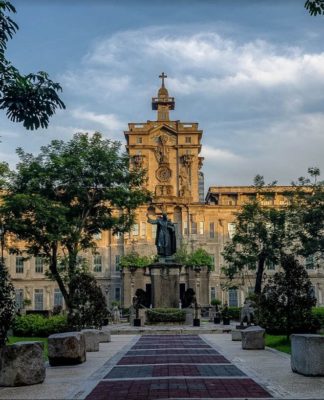HOW DO we determine the authentic apparitions from the hoaxes?
Cautious that visions may have merely pathological or other origins, the Church has ways to examine reports of divine appearances.
The Vatican Congregation for the Doctrine of the Faith (CDF) in its 1978 Guidelines and Norms on the Methods and Procedures for Judging Alleged Apparitions and Revelations, enumerates the criteria for approval of apparitions. They are: (1) sufficiency and coherence of reported data; (2) fidelity of the message to Catholic faith and morality; (3) psychological balance of the visionaries and absence of collective hysteria; and (4) healthy spiritual benefits of the apparitions.
In the autobiographical works of Sts. John of the Cross and Teresa of Avila, apparitions are classified into three: corporeal, imaginative, and intellectual. Corporeal vision occurs when one sees things normally invisible, as how angels appeared to the prophets. Imaginative visions are symbolic, like Joseph and Jacob’s dreams. Meanwhile, intellectual vision is intuitive, when one knows without help from the senses.
Investigations on apparitions and miracles can take decades before being approved.
Back in the ‘50s, the University was involved in the investigation of the “miracle of petals” in Lipa, Batangas, where rose petals with images of Jesus and the saints were said to have mysteriously materialized from the sky. The Rector then, Fr. Angel de Blas, O.P., an expert psychologist, judged Carmelite novice Teresita Castillo, the visionary, to be psychologically sound, but the local hierarchy ruled against genuineness.
“During our time, we (the Dominicans) were involved in the investigation—Fr. Blas, as well as Fr. Carlo Fernandez, counselor of the visionary,” UST archivist Fr. Fidel Villaroel, O.P. told the Varsitarian. “The miracle was condemned, but I have no personal comment on it.”
Attempts are being made to reopen the case by devotees of Our Lady Mediatrix of Lipa and the local archdiocese. Some of the bishops who unanimously disapproved the “miracle” confessed they were coerced to dismiss the reports under threat of excommunication by then papal nuncio Msgr. Egidio Vagnozzi. The controversy is back as movie producer “Mother Lily” Monteverde is planning to produce a movie based on an investigation of the event by journalist June Keithley. The phenomenon was featured in the March 2, 1949 issue of the Varsitarian Magazine.
Science says
The Church employs scientific opinion to determine whether a phenomenon transcends natural causes. Dr. Aste Tonsman, an engineer from the Cornell University in the U.S., has been studying since 1979 the famed image of the Virgin of Guadalupe imprinted on a tilma cloak.
Using space-age visual transmission techniques, Tonsman surprisingly found the image’s iris and pupil reflecting in minuscule the actual scene in 1531, when Juan Diego, the owner of the tilma, showed the image to Church officials and Indians—causing the conversion of nine million Mexicans in the 16th century (see picture).
The Indian “ayate” fabric, made from frail cactus fiber, which deteriorates after 20 years, had lasted more than 470 years to date. Nobel Prize chemist Richard Kuhn and U.S. National Aeronautics and Space Administration researchers Jody Smith and Philip Callahan further found the colors of the image to be of unknown origin: neither vegetable, animal, mineral, nor synthetic.
Scientific tests being done on visionaries, as on Nancy Fowler of Georgia in 1993, reveal that their normal healthy brain would mysteriously relapse, during a state of ecstasy, in brain activity associated with deep sleep or coma. This happens even when the seers are wide awake and communicating sophisticated messages, defying neurological laws.
“Experts and even unbelievers are well encouraged to examine all possible natural explanations to reports of miracles,” Fr. Antonio Aureada, O.P., dean of the Faculty of Sacred Theology, said. “But science has its limits. The moment science forces the issue then its credibility can be questioned.”
The Message
Pope John Paul II, in his encyclical Redemptoris Mater, speaks of the Blessed Virgin’s role toward the Second Coming as the “woman clothed with the sun” who appears in heaven (Rev 12). The Virgin, Mariologists note, before and most specially now, appears in areas “needing urgent correction.” Today, many apparition sites including Garabandal, Spain (1961), and Medjugorje, in the former Yugoslavia (1981) still await Church approval. Others like Akita, Japan (1973) and Kibeho, Rwanda (1981) have received endorsement from the local bishops.
“One of the signs of our times is that the announcement of Marian apparitions is multiplying all over the world,” says Cardinal Joseph Ratzinger, prefect of the CDF, in The Ratzinger Report. However, the Cardinal cautions against wild goose miracle claims that dupe believers to follow cults outside Church sanction.
In the early ‘90s, the Philippine church was racked by accounts of “visionary” Judiel Nieva of Agoo, La Union, which were later proved to be fraudulent.
“Definitely, by fact and by fruit, the so-called apparition in Agoo was a sham,” Fr. Aureada said. “The Church dismisses personality cults where esoteric elements tend to be the ‘it’ of it all.”
Meanwhile, the Church maintains that Catholics are not obliged to believe even in Church-recognized apparitions.
“If ever God allows apparitions to happen, it is meant to deepen our faith,” Fr. Aureada said. “Apparitions cannot offer something radically new to what are already stated as elements of faith, and neither should they be confused with the inspired Word of God.” With reports from June Keithley’s Lipa and Francis Anson’s Guadalupe: What Her Eyes Say















